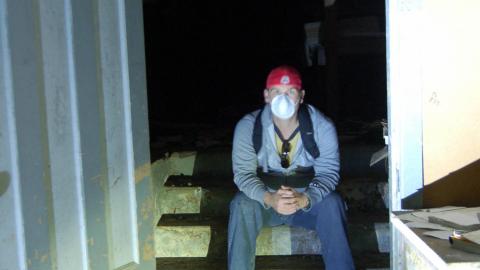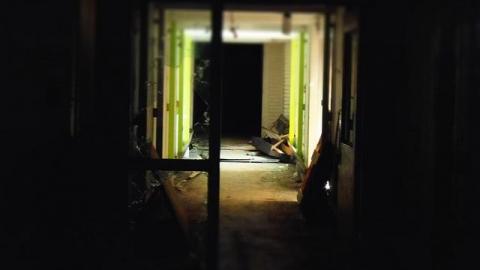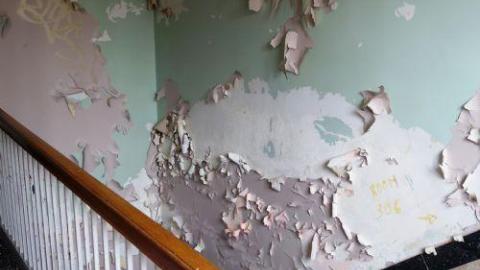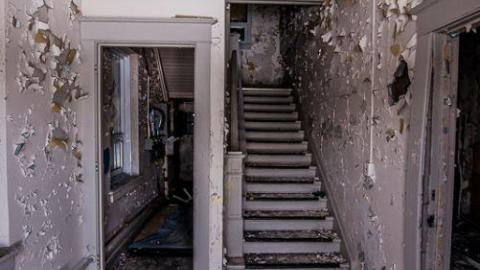About this location
Mountain Sanitarium
Mycobacterium tuberculosis is a contagious bacterial infection which can be spread through coughing or sneezing. During the early 20th century tuberculosis was considered a pandemic that required separating those who had the contagious disease from those who were not infected.
Before the discovery of a vaccine, treatment at the time was to find a location in a tranquil setting where patients could sleep, eat healthy and breath fresh air. The first sanitarium aimed at treated TB patients opened in Germany around 1854.
In Canada, successful businessman William Gage from Ontario was determined to prevent and treat tuberculosis. In 1894 Gage offered the city of Toronto $25,000 towards building a TB hospital but it was met with little interest. In 1896 Gage along with other likeminded individuals formed The National Sanitarium Association to raise funds towards opening TB hospitals and for research funding.
The town of Gravenhurst offered $10,000 which was combined with Gage's $25,000 and used to build Canada's first sanitarium in Muskoka (est. 1897). Sanitariums were operated as for-profit therefore most of the patients were from wealthy backgrounds. In 1902 the Muskoka Free Hospital for Consumptives was built on land belonging to the Ontario Fire College property. It was the first hospital in the world to offer free medical service.
The two hospitals were not enough to meet the growing need as the rate of people infected with tuberculosis increased after the First World War. William Gage purchased some land on the Dennis farm located in Weston, Ontario and opened the Toronto Free Hospital for Consumptives in 1904.
Mountain Sanitarium
On May 28, 1906 the Hamilton Health Association opened the Mountain Sanitarium. This sanitarium was built upon 98 acres of property donated by Hamilton wool merchants W.D. Long and G.H. Bisby. Staff consisted of a matron, nurse, a housekeeper, two ?men of all work? and four patients.
The Mountain Sanitarium began as a simple two tent operation on a farm located on the escarpment overlooking western Hamilton. The tents were able to treat 8 patients. During the same year the tents were replaced with the Crerar Reception Hall, a doctor's shack, a dispensary and laboratory and Dunedin Pavilion.
A Ladies Auxiliary Board was founded which served as the operating committee for the sanitarium. A Gentlemen's Board was also founded which served as the executive committee.
Eventually the tents were replaced with small cottages that were not well insulated against the cold Ontario winters. The cottages were eventually replaced by insulated brick buildings.
A stay in a sanitarium could last for many years. People with TB were often shunned or gossiped about therefore some chose not to disclose their condition to others. Treatment at the time was done by wheeling patients onto the terrace for fresh air.
Dr. Howard Holbrook was superintendent at the Mountain Sanatorium from 1917 to 1945. Holbrook was constantly raising money for construction of new buildings. Some of the new buildings would bear the names of the donors such as the Wilcox, Southam and Evel families.
Preventorium
Children with tuberculosis were treated in the The Preventorium, an infirmary strictly for children. Construction of the Preventorium was completed in September 1906. The term 'preventorium' didn't refer to preventing the disease but rather preventing lifelong debilitating effects from the disease. There were separate wards for boys and girls. (demolished 1952)
Brow Infirmary
On Sept. 26, 1916 the Hamilton Health Association agreed to build the Brow Infirmary. The Brow Infirmary was built to treat World War I soldiers suffering from tuberculosis and lungs exposed to poisonous gasses. The location of the infirmary was intended to keep the often rowdy solders away from the other patients and to take advantage of the air breeze that was available on the location. The cost to build the Brow Infirmary was $146,569 which opened on December 5, 1916. Today the building is used for storage.
Pavilions
In 1917 East and West pavilions were added for dining rooms, wards and vocational training. The vocational training for soldiers would eventually include weaving, leatherwork, metal work, printing, refinishing furniture, picture framing, basketry and wood working. The Eastern pavilion was enlarged in 1922, 1932 and in 1950 to 1952. Today only the Eastern pavilion remains, the Western was demolished in 2001.
In 1923 Mr. Charles S. Wilcox, a member of the Board of Directors donated radio equipment to the sanitarium which allowed them to have their own radio station.
At its height, through the 1920s and 1930s, the sanatarium had more than 700 patients and more than 450 staff members.
A cure
After an antibiotic was discovered by Albert Schatz in 1943, the need for long stays in sanitariums was no longer necessary. In an effort to remain open, the Mountain Sanitarium began accepting Inuit patients from Northern Canada. From 1958 to 1962 a total of 1,272 Inuit patients received treatment at Mountain Sanitarium.
Inuit patients were taught arts and crafts, women learned sewing and men carved soapstone. Inuit patients at the Mountain Sanitarium produced 200 carvings per month which had a retail value of over $10,000 per year (the sanitarium took a 30 per-cent commission). The carving of soapstone was not favored due to the fine dust that was created, and patients had to wear face masks.
Some of the younger Inuit men would go in search of wild rabbits which were then cooked on hot plates.
Life as an Inuit patient could be difficult. Feelings of isolation from family, being tied to the bed, unable to speak the same language as staff and some suffered abuse from staff.
Name Changes
In 1961 the sanatorium changed it's mandate and with the assistance of city and government grants the former four storey Evel Pavilion sanatorium was transformed into a chronic and convalescent general hospital called the Chedoke General and Children?s Hospital. The new hospital had 380 beds available. The name Chedoke comes from a native mispronouncing of Seven Oaks.
When the hospital found itself with a reduction in pediatric services, the Board of Directors voted to change the name to simply Chedoke General Hospital.
In 1971 the Chedoke General Hospital name was changed to Chedoke Hospitals.
On March 24, 1976 the Ministry of Health announced that it intended to close all active treatment beds at Chedoke effective June 1. A public rally was held to support the hospital and more than 750 people attended. A petition with over 80,000 signatures was presented to Minister of Health, Bette Stephenson. Almost a year to the day later the Ministry of Health revised their plan to allow Chedoke to keep 150 acute-care beds. Chedoke was told to plan for a future as a rehabilitation, chronic care and community health centre.
In 1979 Hamilton Health Sciences took over control of Chedoke Hospital and the property assets were handed over to a nonprofit corporation that has sold numerous parcels of land over the years. Chedoke Hospital was amalgamated with the McMaster University Medical Centre to become half of Chedoke-McMaster Hospitals. In 1997 Chedoke-McMaster Hospitals amalgamated with Hamilton Civic Hospitals to form Hamilton Health Sciences. It is now known as Chedoke Hospital of Hamilton Health Sciences.
Today
Today the property is the subject of a contentious debate as to what should happen with the land. The Chedoke Health Foundation sold 24 acres of the brow lands to developer Deanlee Management for $5 million.
Citizens enjoy the land for its fresh air and nature while the developer wants to construct 700 condos on the site, an idea which was rejected by the city of Hamilton. Citizens feel that the plans for the property are too big for the beautiful property that it would be built upon.
Sources: -National Sanitarium Association -Inuit Women: Their Powerful Spirit in a Century of Change (By Janet Mancini Billson, Kyra Mancini) -Historic Hamilton
Albums 15
Comments
Comments
Please log in to leave a comment
what a great place to explore! Too bad its gone, I heard they are putting town houses in its place? :(
Yeah, its gone. No need for FM now. http://www.thespec.com/news-story/4754449-featured-photos-sanatorium-teardown/
Couldn't find anything in the news about it? Can someone get some photos? :( Sad day for Hamiltons history.
yup on its way down, east pavilion is gone, hospital is next then the 3 houses.
No way! They're tearing it down?! I thought it hadn't been approved yet... :( How sad.
fence is up, demolition is in full swing. this place is gone very soon.
this place is awesome it has definitely made the road trip to Hamilton list
Also, everything has been ripped apart by people stealing pipes and copper. The place is destroyed
this place is air tight now. they have boards perfectly cut to each window and sealant around each board
No doubt! I couldn't imagine, you must feel relieved to have it all over with now though eh?
I'm actually closer to some of the other properties of your tour. It's been an insane & sore week with moving kids out of University. I think I needed the rest confining myself to my own home instead of a sanitorium.
Awww darn, had I had known we could have gotten together and explored the creepy sanitorium together supress.
Quite the road trip unleashed, some good choices that I haven't seen yet & I'm virtually around the corner.
Visited yesterday. Lot's of activity, waited about an hour before heading for my POE.
Visited 2 weeks ago and we came across a firetruck and a construction worker. Apparently people had broken in the previous night. The worker said that we better leave before the cops show up and acuse us of doing the damage. Its actively patrolled.
I was there today, found a tunnel to get to main building but didn't go because my female friends were too scared ... LOL ... Will be back soon!
Codi this a combo of my first two and then a third with oap back in July.or august.
R&RF, is this from your first visit and just readding the orginal visit. a recent explore?
Hamilton fire crews are mopping up after a fire in the former brain injury clinic building on the grounds of Chedoke Hospital. The fire was reported about 8:30 a.m. by an HSR driver who noticed smoke coming from the boarded up building near the intersection of Scenic Drive and Sanatorium Road. The fire was upgraded to a second alarm when the first crews to arrive found smoke on the second fl
Freshly sealed with caulking around the boards & covering screw heads. This should be full member.
True... The roof comment was just a joke and my only other comment was that it was boarded up tight.
Denied! Well, one thing to consider is not to discuss the poe in the open but rather keep it to pm's...anyone reading this would know where to target to seal this or any other place up! Knowledge is power and why give it to someone else?
this place looks like it would be interesting! can anyone confirm if there is security monitoring the place and/or if there is a way into the building??? *besides climbing on the roof?*
I'm going back soon probably just to photograph more of the exterior and the grounds...It's so exposed and there are so many joggers and dog walkers going by on Sanitorium I'm not sure I'd take a chance infiltrating!
Point taken...well, the grounds and exterior should make for some nice pics, especially with the crazy autumn weeds about.
This place has silent alarms and sensors You can walk around the area and take photos and what not. But don't try to get in or rattle the doors / windows really hard. Security and cops will show up in less than 5 minutes if you do A father of my sons friend does security there






































11 years ago
So sad. This was one of my favorite explores of all time.